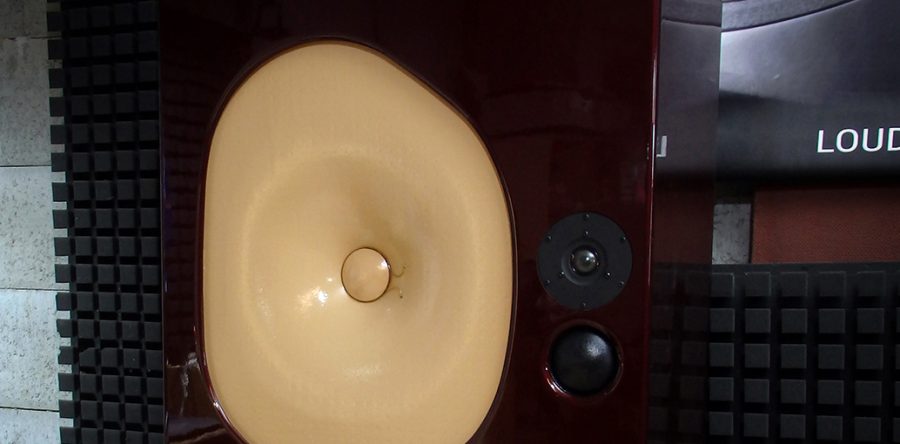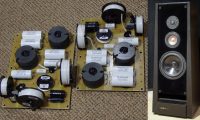crossovers for speaker systems on vintage fullrange drivers
Yamaha JA-5101 / JA-5101A
Very interesting and unusual speaker systems visited my workshop, for the production and tuning of crossovers for them. So I’ll start with a little description.
The basis of these speakers are vintage Yamaha JA-5101 / JA-5101A fullrange drivers. Each speaker uses a pair of such drivers as a mid-bass section in an open-type cabinet. For the mid-high-frequency range, vintage fullrange DEW (Dortmund Magnetfabrik) and Morel ET 338 are used.
An interesting feature of the Yamaha JA-5101 is not only the unusual shape of these drivers, but also the design. There is no traditional suspension of the diffuser, its function is performed by a flat section of the diffuser around the perimeter, which can deform within small limits. In this way, the suspension smoothly transitions from a flat area to a conical diffuser shape.
Measurements of the characteristics of the drivers and a small upgrade

MF – Dortmund Magnetfabrik, HF – Morel ET 338
Frequency response measurements of the drivers were made without filters in the far field from a distance of 1.5 m. An interesting feature: due to the rather large dimensions of the speaker cabinets (in particular, the large dimensions of the front baffle), there is no need for frequency response measurements in the near field, because they practically coincide with measurements in the far field.
The frequency response of the Yamaha JA-5101 drivers is difficult to call uniform, looking at the local frequency response peaks and dips of +/- 5 dB. But if you consider its course in general, i.e. imagine the average line passing through the deviation of frequency response, then this imaginary line will be straight without obvious slopes in the direction of high or low frequencies. The frequency response picture is not as bad as it might seem at first glance.
But the frequency response of medium-frequency vintage drivers Dortmund Magnetfabrik upset me. It resembles the back of a two-humped camel. In fact, this speaker reproduces only 2 narrow frequency bands: 2.5 – 3 kHz and 6 – 8 kHz with a huge gap between these bands of more than 10 dB. It is quite difficult to even out such unevenness of the frequency response with filters, besides, it will greatly complicate the circuit and the cost of crossovers. Therefore, we replaced the mid-frequency drivers with dome Scan Speak D7608/920000
The characteristics and dimensions of the D7608 speakers fit perfectly into the overall speaker scheme, the seating positions did not require significant adjustments to the speaker cabinets. An interesting feature of these drivers is that under a rather large textile dome (Ø 76mm) there is a rigid fixed dome that prevents accidental dents or careless “squeezing” it inside.
High-frequency driver Morel ET 338 has a good uniformity of the frequency response and a wide working frequency band from 1.5 kHz
Crossovers
Crossovers are designed and configured according to the principle of equal frequency response balancing and transparent uncolored sound of these speaker systems.
The crossover scheme is 3.5-way.
A pair of Yamaha JA-5101 drivers are connected in series, with a series filter that splits the input signal between these two drivers. The upper driver reproduces the signal up to 1 kHz, the lower one is limited by a filter 1 octave below. Circuit C1, R1 reduces the sound pressure at low frequencies up to 300 Hz by 3 dB, the “LF 0/+3 dB” switch allows you to turn off this limitation depending on the position of the speakers in the listening room (remember, these speakers are open type)
Sequential inclusion of drivers is necessary to equalize the sound pressure of the JA-5101 pair with the mid-high-frequency drivers.
The mid-range driver Scan Speak D7608/920000 is included through a 1st-order filter on the low-frequency side and a 2nd-order filter on the high-frequency side.
The Morel ET 338 tweeter is limited by a 2nd order filter and has a small frequency response correction circuit.
Filter distribution frequencies: 500 Hz, 1.2 kHz, 2.5 kHz
As can be seen on the graph of the transfer functions of the filters, there is a large gap of 8 dB between the low-pass and mid-pass filters. The electrical characteristics of the filters in this case compensate for the acoustic characteristics of the drivers. Therefore, the overall frequency response of the speaker system does not have this gap.
The impedance is rather uneven, the resistance varies from 3.6 Ohms at the frequency of 2.1 kHz to 34 Ohms at the frequency of the main resonance of the woofers of 40 Hz. Of course, impedance drops of almost 3 ohms may not be to the liking of some amplifiers. But in my deep conviction, the neutral nature of the sound of acoustic systems, their uniform frequency response, are much more important than impedance. The main thing is that the resistance does not fall very low, to 2 ohms, for example. Although I have repeatedly encountered a drop in impedance to 2 ohms in factory speakers and nothing terrible happened to my amplifiers.
Final measurements of the frequency response show uniformity within +/- 2 dB in the “LF 0dB” switch position and +/- 3 dB in the “LF +3dB” position.
The layout of the crossover boards is mirrored, taking into account the mirror layout of the drivers and terminals in the cabinets of the speaker systems.
Traditionally, I use inductors from the Ukrainian manufacturer Vajd-Audio
The speakers are back in their owner’s listening room and I’ve already received positive feedback about their sound.
If you also create DIY projects of speaker systems and you need help with the design and tuning of crossovers or professional advice on their creation, please contact:























